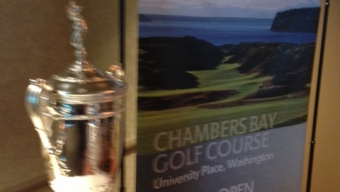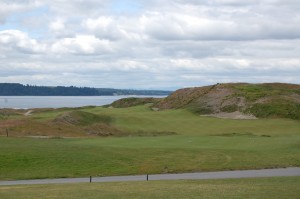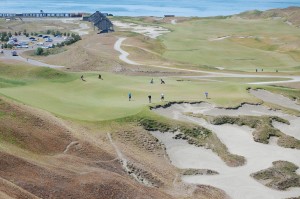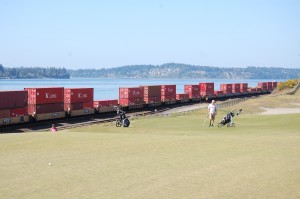SEATTLE – By the time the U.S. Open Championship comes to Chambers Bay, just south of Seattle, in 2015 it will be the first time that golf’s most prestigious event has been played in the Pacific Northwest.
You think that 115 years is a long enough waiting period?
Certainly, the region has been under-represented for the championship but that does not mean it is unprepared. Ever since the first bulldozer chased away the dirt bikes from the old gravel pit 10 years ago and drew a line in the sand, USGA folks have shadowed the development of this choice 250-acre piece of property along the Puget Sound.
In 2008, just 18 months after Chambers Bay opened for business, the USGA announced that it had selected Chambers as its Open site in 2015. It was unprecedented for a new course to be awarded such a honor. The grass wasn’t fully in. The layout was quite a bit different then than it is now. There was and still is no clubhouse. Few people had even heard of the course.
Time was short and the logistics list was long. That was why the USGA sent its U.S. Open Championship operations manager Danny Sink to live in the Seattle area 14 months ago, a year ahead of its usual schedule. That’s why Mike Davis, the USGA’s executive director who championed the Chambers selection, visits the site a half dozen times a year and calls three or four times a month. He takes a personal stake in its success – or failure.
That’s also why the USGA put together a press conference in Seattle Tuesday to provide a timetable for the media on what’s been done and what challenges lay ahead.
“This is the biggest sports event that has ever come to this region,” Sink said.
That’s up for debate but there is some validity to that argument.
What makes the USGA hover over this particular event is because there are a number of unusual ‘firsts’ for the U.S. Open Championship.
It is the first time the Open has ever come close to the Northwest. In fact, the event, which began in 1895, didn’t cross the Mississippi until 1916, when it was held in Minneapolis. It wasn’t contested out ‘west’ until 1938 in Colorado. The first of 11 events held in California didn’t begin until 1948. However, it has been held in California three of the past six years, so the trend is westerly, not so much northwesterly.
It’s the first time that the entire course will be played on fescue grass, including the greens. Fescue presents a different and perhaps more difficult roll that the professionals rarely experience. The jury is out as to how that will go over among the PGA brethren and frankly the thickness, cut and growth of the greens are still being determined.
It’s also the first time the U.S. Open will be played on a ‘true’ links course. Chambers was built by the Robert Trent Jones, Jr., team in and around the natural contours of the terrain, although the bulldozers still shaped many of the holes. What the golfers will find is a British-Open style event in which they can use the slopes and banks to sneak up on the hole.
“That’s what Mike Davis wants. He wants those guys challenged on every shot,” Sink said. “He doesn’t want two shots the same the entire length of the championship. There are five different ways to play every hole out there based on pin placement, teeing areas, what we do with the fairways. It’s truly going to be a challenging golf course.”
There was a ‘test run’ for the Open three ago when the 2010 U.S. Amateur was held at Chambers. Peter Uihlein defeated David Chung 4 & 2 for the title. Patrick Cantlay, one of the bright young stars on the PGA Tour, also reached the semifinals.
Larry Gilhuly, Northwest director of the USGA’s Green Section, has been marshaling the development of the course and reporting back to Davis.
“From a playing standpoint, it’s going to be unique. This is not a normal golf course,” Gilhuly said. “You are going to see a creation of shots that are out of this world. We saw that at the Amateur, where guys were hitting up banks and bringing it back. That’s what’s going to make it unique.”
Since the Amateur, there have been a number of changes to the course, new greens established, lengthening holes, setting up new tees and contouring the slopes for what could be the longest course in Open history, about 7,800 yards. It probably will play around 7,500.
No. 1, for example, was a par-4, just under 500 yards but the amateurs were driving over the slopes and easily reaching the green in regulation. It was decided to move the tee back to 575 yards and it will be designed a par-4 or a par-5 during the four-day event. The finishing hole also will rotate between a par-4 and a par-5.
One of the final changes is on the par-3, 227-yard ninth hole, high on a bluff above the course. It has a left-to-right sloping green and many of the drives during the Amateur rolled off the green into the waste area. A new tee is being built into the hill to the north of the hole. It will provide a more direct shot into the green, about 188 yards, and allow for more accommodating pin placements.
“The angle is completely different,” Gilhuly said. “It’s going to be fun to see how they hit it from there. If they use the wrong club and hit it high on the hill (behind the pin), it will roll right back into the bunker. And if it’s short, it’s in the bunker.”
There is also a ”third’ to this event. This is the third time the championship has been held at a municipally-owned (Pierce County) facility, joining Bethpage and Torrey Pines. That presents a host of outside-the-ropes issues for Sink and his staff to solve, parking, transportation, housing, clubhouse and tent setups, tickets, volunteers, etc.
“I”m going to Pinehurst (in 2014) for the third time. It’s like going to my own house,” said Pete Kowalski, the USGA’s director of championship communications who flew in from New Jersey for the press conference. “But coming to Chambers Bay, it becomes ‘how do we do that?’ ”
Sink said that he is “close to a deal” to allow trains to drop off spectators at a train depot adjacent to the course. He said about 4,500 volunteers will be needed and all should be accepted and ready for training a year before the event.
They expect to attract about 35,000 spectators a day with 2,000 media representatives. The week-long festivities – June 15-21 – should drop about $140 million into the area’s economy.
“Ten years ago it would have been inconceivable what Mike has brought to this area,” Kowalski said.
























